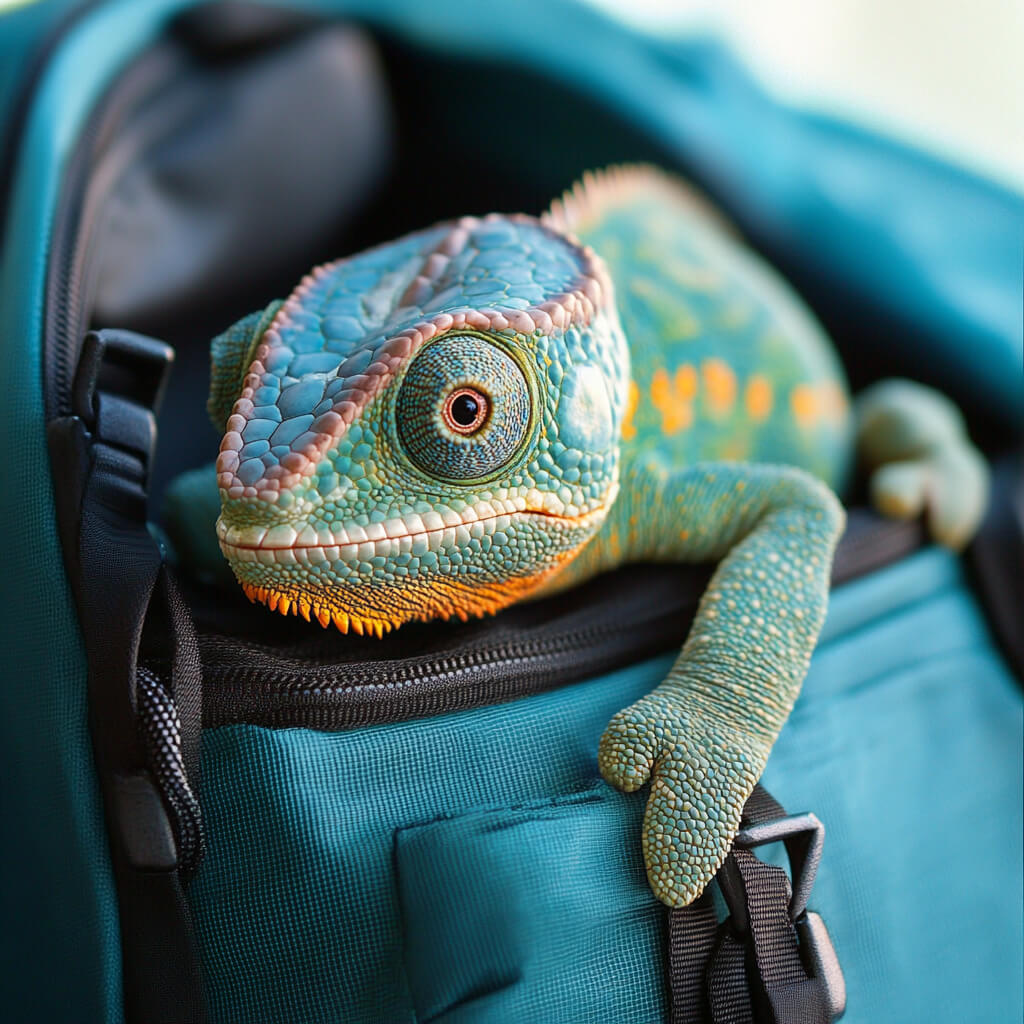“What if my chameleon freaks out during the car ride?”
“How do I keep them from turning black and hissing at me?”
I’ve been there.
When I first moved cross-country with my veiled chameleon and, I learned the hard way.
Let’s skip the panic and get to what actually works.
1. Prep Like a Pro: Your Chameleon’s Travel Survival Kit
The Container:
- Use a small, ventilated plastic bin (think: 12”x8” for adults). Drill holes or use mesh panels.
- Pro Tip: I repurposed a $5 Sterilite container – added 20 pencil-sized holes. Steve could see out but couldn’t escape.
- Line the bottom with paper towels. No loose substrate – it’s a choking hazard and messy.
Acclimate Early:
- Leave the travel container in their habitat 2-3 days before the trip. Feed them inside it. They’ll stop associating it with “DOOM.”
Temperature Control:
- 70-75°F is ideal. Too cold? Tape a hand warmer (wrapped in a sock) to the outside of the bin. Too hot? Freeze a water bottle, wrap it in a towel, place nearby.
- Never put heat/cold sources inside the container. Burns happen.
Hydration Hacks:
- Mist them 30 mins before departure. No spraying during travel – humidity spikes stress them.
- Place a shallow water dish (think: bottle cap) inside. They’ll sip if thirsty.
2. During the Trip: Keep It Boring (Seriously)
Secure the Container:
- Buckle it in with a seatbelt or wedge it between bags/blankets. No sudden slides.
- Never put them in the trunk. Exhaust fumes + zero airflow = disaster.
Drive Like You’re Transporting Nitroglycerin:
- Smooth accelerations. Gentle turns. Avoid potholes.
- Blast death metal? Hard no. Play podcasts or nothing. Noise = stress.
The “Don’t Peek” Rule:
- Check on them every 1-2 hours. Do not open the container unless necessary. Every peek resets their stress levels.
- Story Time: I opened Steve’s bin at a gas station – he bolted up my arm and turned neon red. Took 45 mins to calm him down.
3. Post-Travel Recovery: Let Them Chill
Reintroduce Slowly:
- Place their travel bin inside their habitat for 1-2 hours. Let them crawl out on their own terms.
Hydrate + Feed:
- Mist their plants heavily. Offer favorite bugs (gut-loaded crickets work).
- They might refuse food for 24-48 hours. Normal.
Watch for Stress Signals:
- Dark colors, puffing up, hissing = back off.
- Sunken eyes, lethargy = vet time.
FAQs (From One Paranoid Owner to Another)
Q: How long can chameleons safely travel?
A: 4-6 hours max. For longer trips, stop overnight. Set up a temporary habitat (small cage, branches, UVB light).
Q: Can they fly on planes?
A: Most airlines ban reptiles in cabins. Ship via specialized reptile transport services (not FedEx).
Q: Should I handle them during rest stops?
A: Only if necessary. Use gloves – stress makes them bite.
Q: What if they won’t eat after traveling?
A: Wait 48 hours. Still no appetite? Vet check.
Bottom Line: Traveling with chameleons isn’t “fun,” but it’s doable. Prep their space, drive like a grandma, and let them decompress afterward. Steve’s survived 3 moves and a 10-hour road trip – if he can handle it, yours can too.
Key Takeaway: Minimizing stress during travel starts with a solid plan – your chameleon’s sanity (and yours) depends on it.




Leave a Reply